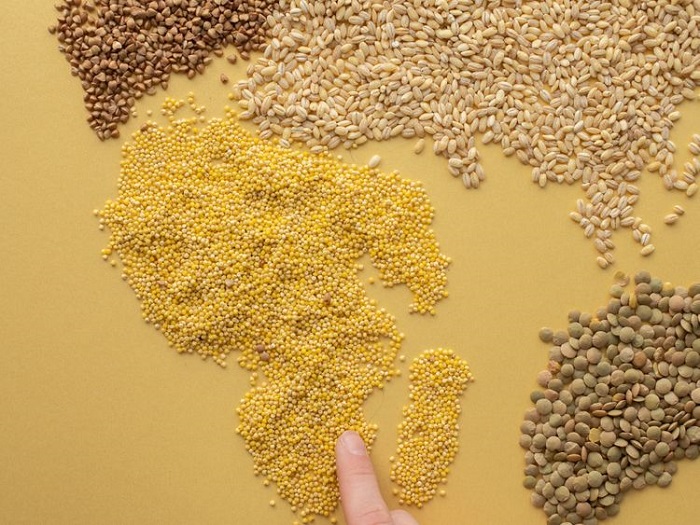
The Indian government’s obsessive promotion of millets has included demanding the ‘humble grain’ to be used in most official functions. Bureaucrats are said to be suffering from millet fatigue and are on a silent campaign to demand the return of some rice and wheat-based food.
Millets, or traditional Indian coarse grains, are good for so many reasons that it seems a bit too good to be true. Obesity, diabetes, nutrition, water conservation and air pollution are just some things that come to mind when we think of millets.
Of these, there is quite some awareness already about the health benefits of millets. They have a considerably lower glycemic index than refined white flour and rice. Eating a bajre ki roti, or pearl millet bread, is likely to make you feel full for longer, and less bloated. Fibre-rich millets are also better at being a source of nutrients than rice and wheat. They’re also gluten-free.
If the consumption of rice and wheat in India was overnight replaced with millet, we’d have a lot less obesity and diabetes. Millets are better at giving you not just fibre and protein but also several vitamins and minerals.
How we forgot millets
These were the foodgrains Indians mostly ate for thousands of years, but few urban Indians remember doing so now. India’s Green Revolution in the 1960s made wheat and rice reach every household. Since these have more carbohydrates than millets, are easier to process and store, Indians took to them like fish to water. The sugar rush of carbs is addictive too.
Such is the prevalence of wheat and rice that a state like Rajasthan, famous for bajre ki roti, is now eating wheat and rice in large numbers. It is a shame that you can’t get bajre ki roti in most restaurants in Jaipur. Rajasthan is the largest producer of millets, mostly bajra.
Often we don’t have an option: the government’s public distribution system that gives foodgrains to the poor at subsidised prices or even for free, does not include millets. If you buy multigrain flour at a grocery store, it’s more wheat than millets.
The impact of the excessive consumption of wheat and rice is not just on our health. It is also on our environment. It takes a lot of water to produce them. When we export our wheat and rice, the joke is that we are exporting our water.
One of the most water-rich places in the world, blessed with rivers like the Ganga and a magical phenomenon called the monsoon, India is running out of groundwater. This is not just the pressure of a large population but also of water-intensive crops like paddy, wheat and sugar cane. Millets take very little water, and much less time to grow.
Eat millets to reduce air pollution
Personally, the best reason to eat millets is to think I’m helping reduce air pollution by doing so. Every year, the onset of winter in North India coincides with the harvesting season for paddy. The stubble residue from wheat has to be disposed of quickly, because there’s a short window in which farmers need to sow paddy.
The easiest thing to do is to burn the stubble. The smoke affects all of India — the worst affected is Delhi, since Delhi’s geography is particularly adept at trapping particulate matter in the winter. Only when the weather changes is the pollution swept away.
Farmers in Punjab, Haryana and western UP know the pollution their stubble burning causes. They’re also happy to move back to growing millets.
The farmers in Punjab I have spoken to have explained that they are running a business. (The farmers in Punjab say they are running a business) They grow what sells. If people want millets, they’ll grow millets.
Therefore, the Indian government’s hyperactive promotion of millets is a welcome move. But it’ll take much more.
Where’s the supply?
Farmers also say that millets don’t have a robust supply chain that would make it easy to sell them. Most of all, farmers want assured income. They take huge risks sowing a crop. They want to know exactly how much money they are going to make at the end of the crop cycle.
To make farmers grow wheat and rice in the 1960s, as part of the Green Revolution that addressed India’s food shortages at the time, the Indian government told farmers it was going to directly buy the foodgrains at a fixed price, the Minimum Support Price or MSP.
Today, this MSP is a burden on the exchequer. The Indian government would like farmers to sell their produce to the private sector.
The government gives MSP on only three kinds of millets — jowar, bajra and ragi. But this exists only on paper. In fact, the government procures very little millets for the PDS system.
If the government increases its procurement, farmers will begin shifting to millets. This is a problem that once again needs better focus on the processing, supply and storage of millets.
That’s when the government will be able to procure them in larger numbers. More kinds of millets should be included in the MSP regime. In short, it is the government that has to take the lead in reducing our dependence on wheat and rice. Creating demand is one thing, addressing the supply will be much tougher.
The Indian government has announced that it will soon start giving free foodgrains to about 3/4ths of the population — over 80 crore Indians. Now is the time to make a transformative move towards millets.
India’s agriculture minister has said that government will start procuring more millets, and India’s recent national budget made some moves towards better research on and marketing of millets. The taste of the bajre ki roti, however, will be in the eating. (Gulf News)


